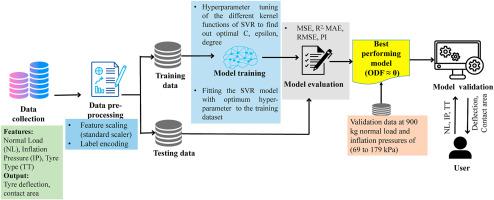当前位置:
X-MOL 学术
›
Eng. Appl. Artif. Intell.
›
论文详情
Our official English website, www.x-mol.net, welcomes your feedback! (Note: you will need to create a separate account there.)
A machine learning-based approach for estimation of deflection and contact area characteristics of tubeless and tube-type agricultural tyres
Engineering Applications of Artificial Intelligence ( IF 8 ) Pub Date : 2024-04-01 , DOI: 10.1016/j.engappai.2024.108357 Rajesh Yadav , Hifjur Raheman
Engineering Applications of Artificial Intelligence ( IF 8 ) Pub Date : 2024-04-01 , DOI: 10.1016/j.engappai.2024.108357 Rajesh Yadav , Hifjur Raheman

|
Support Vector Regression (SVR) models with different kernel functions (radial basis and polynomial) were developed for predicting deflection and contact area of tubeless and tube-type tractor tyres. Data were collected from experimental trials on 13.6–28 tubeless and tube-type tyres under varying loads (750–1400 kg) and inflation pressures (69–179 kPa). A displacement transducer comprising a rack-pinion arrangement and a rotary potentiometer was developed for measuring tyre deflection. A total of 168 data points were split into 70% for training and 30% for testing the SVR models. An additional 42 new data points were collected at a normal load of 900 kg for validation purpose. As compared to tube-type tyre, tubeless tyre had higher contact area at higher normal loads due to higher tyre deflection. Two SVR models were constructed by considering normal load, inflation pressure, and tyre-type as input parameters. The well-trained SVR model could predict tyre deflection with a maximum deviation of 2% from the measured values as compared to −21% in case of Wulfsohn model. Similarly, the predicted contact area had a maximum variation of 1% from the measured values as compared to 9.99% in case of Komandi model and 31% in case of Diserens model. The sensitivity analysis indicated that the proposed models ranked normal load as the highest priority followed by inflation pressure and tyre-type for estimating both tyre deflection and contact area.
中文翻译:

基于机器学习的方法,用于估计无内胎和有内胎农用轮胎的偏转和接触面积特性
开发了具有不同核函数(径向基和多项式)的支持向量回归(SVR)模型,用于预测无内胎和有内胎拖拉机轮胎的偏转和接触面积。数据是在不同负载(750-1400 kg)和充气压力(69-179 kPa)下对 13.6-28 无内胎和有内胎轮胎进行的实验试验中收集的。开发了一种包括齿条小齿轮装置和旋转电位计的位移传感器,用于测量轮胎挠度。总共 168 个数据点分为 70% 用于训练,30% 用于测试 SVR 模型。为了验证目的,在 900 kg 的正常负载下收集了另外 42 个新数据点。与有内胎轮胎相比,无内胎轮胎由于轮胎挠度较高,因此在较高正常负载下具有更大的接触面积。通过考虑正常负载、充气压力和轮胎类型作为输入参数构建了两个 SVR 模型。训练有素的 SVR 模型可以预测轮胎变形,与测量值的最大偏差为 2%,而 Wulfsohn 模型的最大偏差为 -21%。同样,预测接触面积与测量值的最大偏差为 1%,而 Komandi 模型为 9.99%,Diserens 模型为 31%。敏感性分析表明,所提出的模型将正常负载列为最高优先级,其次是充气压力和轮胎类型,以估计轮胎变形和接触面积。
更新日期:2024-04-01
中文翻译:

基于机器学习的方法,用于估计无内胎和有内胎农用轮胎的偏转和接触面积特性
开发了具有不同核函数(径向基和多项式)的支持向量回归(SVR)模型,用于预测无内胎和有内胎拖拉机轮胎的偏转和接触面积。数据是在不同负载(750-1400 kg)和充气压力(69-179 kPa)下对 13.6-28 无内胎和有内胎轮胎进行的实验试验中收集的。开发了一种包括齿条小齿轮装置和旋转电位计的位移传感器,用于测量轮胎挠度。总共 168 个数据点分为 70% 用于训练,30% 用于测试 SVR 模型。为了验证目的,在 900 kg 的正常负载下收集了另外 42 个新数据点。与有内胎轮胎相比,无内胎轮胎由于轮胎挠度较高,因此在较高正常负载下具有更大的接触面积。通过考虑正常负载、充气压力和轮胎类型作为输入参数构建了两个 SVR 模型。训练有素的 SVR 模型可以预测轮胎变形,与测量值的最大偏差为 2%,而 Wulfsohn 模型的最大偏差为 -21%。同样,预测接触面积与测量值的最大偏差为 1%,而 Komandi 模型为 9.99%,Diserens 模型为 31%。敏感性分析表明,所提出的模型将正常负载列为最高优先级,其次是充气压力和轮胎类型,以估计轮胎变形和接触面积。



























 京公网安备 11010802027423号
京公网安备 11010802027423号